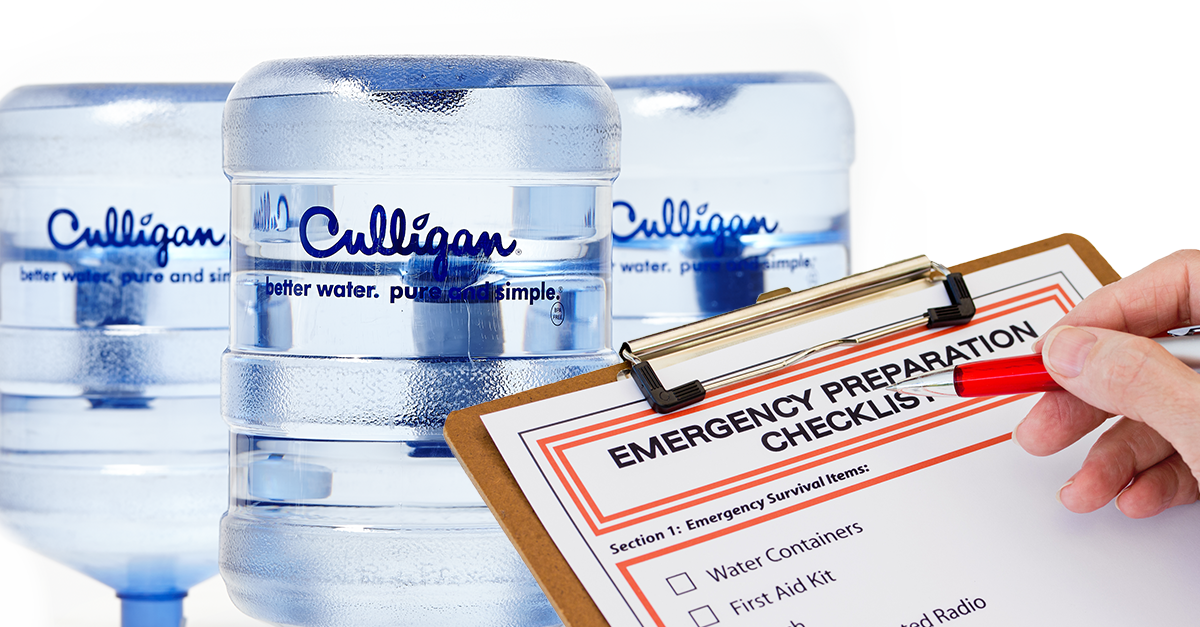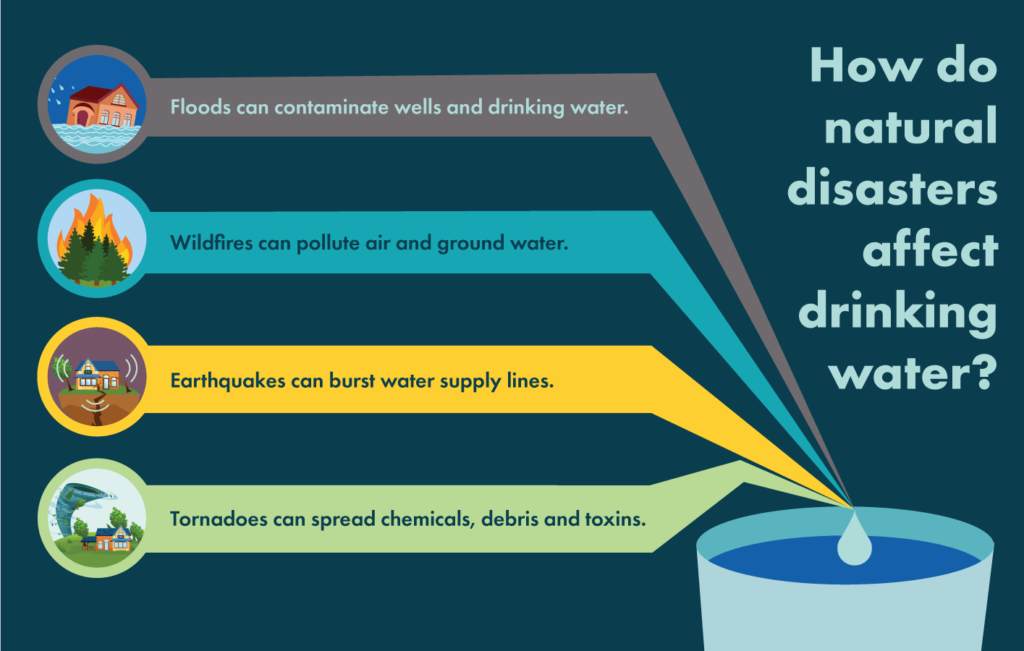Natural Disasters and Drinking Water: How to Keep Your Family Safe
Natural disasters can have devastating effects on communities. In addition to power outages and property damage, they can affect access to clean and safe drinking water.

There are several things for your family to consider when preparing for extreme weather. And maintaining a safe drinking water supply during a natural disaster should be at the top of your list.
Preparing your supply and stocking up on clean water is key.
How much water do you need?
The Center for Disease Control recommends that you store at least one gallon of water per day for each person and pet in your family. But if you live in warmer climates, are pregnant or are suffering from an illness, consider stocking up on even more.
At a minimum, plan for using a three-day water supply when a natural disaster hits. However, if you are capable of storing more, try preparing a two-week water supply.
How should you store your drinking water supply?
In addition to the amount of water needed, it is important to think about the types of containers used. When pre-filling containers with tap or filtered water, it is crucial to use thoroughly sanitized, food-grade plastic or glass.
Milk containers, whether half or full gallon, tend to be difficult to clean. Plus, bacteria can grow quickly on these surfaces. So if a milk jug is your only option, take extra care when sanitizing.
Bottled water is another great option. Culligan bottled water can offer your family some relief, because it meets or exceeds all federal and state health water regulations.
Where is the best place to store water?
Don't forget that location matters. Be sure to store your prepared supply in a place that will remain safe from potential flooding.
Direct heat and light can also affect plastic containers, so it is best to keep water containers in a dark, dry and cool place.
How do you know if your water has been contaminated?
Certain natural disasters can cause damage or flooding to wells and municipal water supplies, resulting in contamination of your tap. And sometimes the appearance of water can clue you in as to whether this has occurred.
If your water has a cloudy look, foul taste or rotten smell, it is likely that it is not safe for consumption. However, it is important to note that some dangerous contaminants cannot be detected by sight, taste or smell.
If you are unsure about the quality of your water following extreme weather, your local water expert can collect a sample and send it to an EPA-certified lab for analysis.
How exactly do natural disasters affect drinking water?

Floods, Hurricanes and Tsunamis
An extreme flood can contaminate drinking water supplies and wells. When flood water rises, it picks up bacteria, organisms and contaminants from the ground, on the sides of buildings or anything else it touches.
Some contaminants spread through water include:
Nitrates
Nitrates are ultra-soluble in water. And that means excess rainfall and over-irrigated soil can spread the contaminants. They can leech below a plant's root zone and pollute groundwater.
This can be worse for homeowners with well water. Especially those near livestock facilities and sewage disposal sites. Nitrates are a health risk specifically for pregnant and nursing women. As well as infants, young children and the elderly.
In addition, this contaminant is the culprit of blue baby syndrome. Which affects infants less than six months of age. Blue baby syndrome causes veins and skin to appear blue, since blood is no longer able to carry enough oxygen to body cells.
Studies also show that long-term exposure to nitrates has been linked to cancer in every animal species tested.
Total Coliform
Total coliform is a catch-all term. Which indicates whether your water source has been exposed to environmental contamination from soil, plants or animals.
However, total coliform isn't necessarily harmful. In fact, most species of coliform have no impact on human health. Instead, total coliform is a warning sign that your water supply is at risk of contamination from other disease-causing pathogens.
Fecal Coliform
Fecal coliforms are a subgroup of total coliforms. And generally speaking, these species of coliform bacteria originate from the feces of warm-blooded animals, including humans.
They can enter your water supply through a failing septic system or runoff water contaminated by animals or agriculture.
If your water contains fecal coliforms, you should switch immediately to bottled water. Fecal coliforms do not necessarily indicate the presence of harmful pathogens, but are a sign of high risk.
E. Coli
E. coli is the strongest indicator of contamination from dangerous waterborne diseases. Therefore, if your water contains E. coli you should switch immediately to bottled water.
Scientifically known as Escherichia coli, this species of coliform bacteria is usually harmless - minus a handful of toxic strains.
Symptoms of infection include cramping, sudden and severe diarrhea, fatigue and fever. In addition, complications can include anemia, urinary tract infections, respiratory illness, pneumonia, kidney failure and death.
Chlorine
Chlorine is used to disinfect water. And it's primarily used in municipal water supplies and pools. Although chlorine smells and tastes unpleasant, it does not cause severe health issues in small amounts.
However, chlorine can make your skin, hair and clothing feel dry and itchy.
Wildfires
Wildfires can also pollute the air and ground water. When wildfires burn, smoke, debris and ashes are released. In addition, other contaminants are released with the burning of fossil fuels, like mercury and TDS.
Mercury
Burning fossil fuels, as well as other human activities, produce mercury. It can additionally be found in drinking water as a result of the natural degassing of the earth's crust.
Too much mercury in the body damages the brain and kidneys. And it's particularly dangerous for developing fetuses.
Total Dissolved Solids (TDS)
Total dissolved solids, or TDS, is a term used to describe a large group of water contaminants.
TDS is a group of inorganic compounds. Like calcium, magnesium, potassium, sodium, bicarbonates, chlorides and sulfates. As well as some small amounts of organic matter that dissolve in water.
TDS concentration presents more aesthetic issues than health hazards. But, a high concentration of TDS may result in corrosive water, a salty taste or scale formation.
Earthquakes
Earthquakes can burst water supply pipelines. And pipes in older buildings. This can cause lead contamination in streams, rivers and other drinking water supplies.
Lead
There is no safe level of lead exposure, according to the EPA. Lead does not have an obvious color, smell or taste in water. So it is extremely difficult to detect.
Above a certain limit, lead is particularly dangerous for children. They can suffer behavioral issues, learning problems, slowed growth, hearing problems and anemia.
In rare cases, ingestion of lead can cause seizures, coma and death. In addition, pregnant women are especially at risk to the adverse effects of lead. And this includes reduced growth of the fetus and premature birth.
While it is most dangerous for infants and children, lead is also harmful to adults. Exposed individuals can experience increased blood pressure, decreased kidney function and reproductive problems.
Tornadoes
Tornadoes can spread chemicals, debris, toxins and sediment into the air and water supplies.
Sediment
Sediment is naturally occurring in water and caused by weathering or erosion.
Cloudiness or haziness in water are a result of high sediment levels. The higher the sediment level in drinking water, the greater chance you have of developing gastrointestinal diseases.
How can you treat contaminated water?
After a natural disaster, you can treat your water several different ways.
Boiling water
Boiling water can destroy dangerous chemicals, contaminants and pathogens. Government officials will often issue a boil-water advisory or notice when a water supply is compromised.
Bottled water and properly boiled water are both suitable for consumption in the event of a water infection.
The Centers for Disease Control and Prevention recommends that water be brought to a rolling boil for one minute to kill protozoa, bacteria and viruses. And at altitudes above 6,000 feet, boiling should extend to 3 minutes.
It's important to note that improperly boiled water won't kill harmful pathogens.
If your water is contaminated, use bottled water for:
- Drinking
- Washing hands
- Brushing teeth
- Washing fruits or vegetables
- Preparing food
- Making baby formula
- Making coffee, tea or other drinks
- Pets
- Washing dishes
Infected water can still be used for:
- Laundry
- Showering (if no water is consumed)
Reverse Osmosis
Another great treatment option is reverse osmosis. Reverse osmosis (RO) involves forcing water through a very fine, semi-permeable membrane. This membrane reduces up to 99 percent of impurities, only allowing fresh and safe water to pass through.
